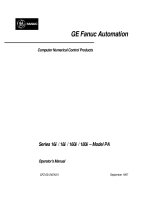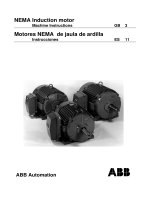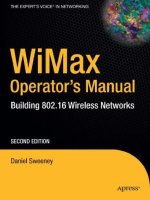Radar Kelvin Hughes KH2020 operator manual
Bạn đang xem bản rút gọn của tài liệu. Xem và tải ngay bản đầy đủ của tài liệu tại đây (35.15 MB, 510 trang )
SYSTEM HANDBOOK
for the
NUCLEUS 3 RADAR SYSTEMS
PUBLICATION KH 2020
Original
May 2001
Nucleus 3 Software Version 2.0x
ARPA 3 Software Version 4.x
RIU Software Version 1.0x
TIU Software Versiion 1.0x
KELVIN HUGHES
Kelvin Hughes Limited
New North Road, Hainault, Ilford, Essex IG6 2UR, UK
Telephone: +44 20 8500 1020
Facsimile: +44 20 8559 8526
Telex: 896401
www.kelvinhughes.com
www.smiths-aerospace.com
A part of Smiths Aerospace - Marine Systems
Registered Office:765 Finchley Road, London NW11 8DS
Incorporated in England No. 1030135
VAT No: GB 226 6019 770 1
KH 2020
CONFORMITY STATEMENT
This system has been designed to comply with IMO regulations and IEC standards.
EQUIPMENT
IMO REGULATION(S)
IEC STANDARD(S)
Radar
IMO A.477(XII)
MSC 64(67) Annex 4
IEC 936.1988
IEC 60936-1
HSC Radar
IMO A.820(19)
IEC 60936-2
ARPA
IMO A.422(XI)
IMO A. 823(19)
IEC 872-1987
IEC 60872-1
ATA
MSC 64(67) Annex 4
IEC 60872-2
EPA
MSC 64(67) Annex 4
IEC 60872-3
COPYRIGHT
ã Copyright Kelvin Hughes Ltd. 2001
All rights reserved. No part of this publication may be
reproduced, transmitted, transcribed, translated or stored
in any form or by any means, without the written
permission of Kelvin Hughes Limited.
Technical details contained in this publication are subject to
change without notice.
May 01
ii
Original
KH 2020
AMENDMENT RECORD
When an amendment is incorporated into this handbook, the details should be recorded below. If the equipment
has been modified, the modification number is shown on the Amendment instruction page.
No.
Date Inserted
Initials
Mod
No.
No.
1
Sep 01
DFB
-
31
2
Oct 01
DFB
-
32
3
Nov 01
DFB
-
33
4
Nov 02
GJS
-
34
5
Jul 03
CRB
-
35
6
Sep 03
CRB
Initials
Mod
No.
36
7
37
8
38
9
39
10
40
11
41
12
42
13
43
14
44
15
45
16
46
17
47
18
48
19
49
20
50
21
51
22
52
23
53
24
54
25
55
26
56
27
57
28
58
29
59
30
60
Amdt. 5
Date Inserted
iii
July 03
KH 2020
ELECTRIC SHOCK
RESUSCITATION
1
SHOUT FOR HELP. SWITCH
OFF ELECTRICITY IF POSSIBLE.
2
3
REMOVE FROM DANGER.
REMOVE OBVIOUS
OBSTRUCTION TO
BREATHING.
Do this immediately. If not possible, don't waste time Safeguard yourself when removing casualty from hazard. If casualty is not breathing start
If casualty is still in contact with electricity, and the supply resuscitation at once.
searching for a switch.
cannot be isolated, stand on a dry non-conducting
material (rubber mat, wood, linoleum).
Use rubber gloves, dry clothing, length of dry rope or wood
to pull or push casualty away from the hazard.
PINCH THE NOSE
COMMENCE VENTILATION
FOUR GOOD INFLATIONS
MOUTH TO MOUTH
LOOSEN NECKWARE
TILT HEAD BACKWARDS
AND PUSH CHIN UPWARDS
IF CHEST DOES NOT RISE
RE-CHECK AIRWAY.
REMOVE OBSTRUCTION
AND RE-INFLATE
CHECK PULSE
POSITION OF PULSE
PULSE PRESENT
PULSE ABSENT
HEART HAS STOPPED BEATING
LAY ON BACK ON FIRM SURFACE
eg FLOOR
COMMENCE EXTERNAL CHEST
COMPRESSION AND CONTINUE
MOUTH-TO-MOUTH VENTILATION
ONE FIRST AIDER
15 Compressions of 80 per
minute followed by two
inflations
CONTINUE INFLATIONS
UNTIL RECOVERY OF
NORMAL BREATHING
TWO FIRST AIDERS
One conducts chest
compressions, without
pause at 60 per minute.
The other administers
mouth-to-mouth ventilation after each 5th compression
WHEN NORMAL BREATHING COMMENCES
PLACE CASUALTY IN RECOVERY POSITION
Check heart beat after first five
minutes and then after every three
mintutes. Continue external chest
compression and mouth-to-mouth
ventilation until a normal pulse is
felt and colour improves
CONTINUE INFLATIONS
UNTIL RECOVERY OF
NORMAL BREATHING
Keep casualty at rest. Remove on a stretcher.
Watch closely, particularly for difficulty in
breathing. Lightly cover with blankets or other
materials.
MEDICAL ASSISTANCE MAY BE OBTAINED ON / AT ...............................
May 01
iv
Original
KH 2020
SAFETY WARNINGS
CD-0845
WARNING
THIS EQUIPMENT IS NOT FITTED WITH SAFETY INTERLOCKS. LETHAL VOLTAGES ARE PRESENT
WHEN THE UNITS ARE OPEN AND EXPOSED. BEFORE REMOVING ANY SUB-UNIT OR PCB, ALL
SUPPLIES MUST BE SWITCHED OFF.
WARNING
ENSURE THAT THE DISPLAY IS SWITCHED OFF PRIOR TO CLEANING THE SCREEN. OTHERWISE
STATIC BUILD-UP MAY PRODUCE ELECTRICAL DISCHARGES WHICH, IN EXTREME CASES, COULD
BE HAZARDOUS.
CD-0844
WARNING
THIS EQUIPMENT CONTAINS MATERIALS WHICH PRODUCE TOXIC FUMES WHEN BURNT.
Original
v
May 01
KH 2020
SAFETY WARNINGS
ANTENNA RADIATION HAZARD
INJURY CAN RESULT FROM EXPOSURE TO THE MAIN BEAM OF A RADAR ANTENNA AT A DISTANCE FROM
THE CENTRAL FRONT FACE, OF LESS THAN:
1.3m (X-Band) Antenna: 3.0 metres
1.8m (X-Band) Antenna: 2.3 metres
2.4m (X-Band) Antenna: 1.5 metres
2.9m (S-Band) Antenna: 1.1 metres
3.9m (S-Band) Antenna: 0.8 metres
WARNING
DO NOT OPEN ANY OF THE EQUIPMENT UNITS WHEN THE RADAR IS OPERATIONAL.
ANTENNA ROTATION
ANTENNA ROTATION CAN BE HALTED BY SWITCHING THE DISPLAY TO STANDBY OR OFF.
SERVICING
THE EQUIPMENT SHOULD BE SERVICED BY AUTHORISED AGENTS ONLY.
May 01
vi
Original
KH 2020
SAFETY WARNINGS
Mains Voltage
All Kelvin Hughes equipment is supplied with Mains Voltage set for 220V, unless stated otherwise on
labels attached to the equipment.
S-Band Tuning
It may be necessary to re-tune the transmitter when changing the pulse length.
Picture Freeze
The rare event of Processor failure is indicated by non-operation of the trackerball, no update of screen data and
a frozen tune bar indicator. The radar picture may be updated, but plotting is not possible.
The display is to be switched OFF and ON again to reset the Processor.
ARPA Failure
The ARPA computer is protected by a watchdog circuit, which monitors the ARPA for correct operation.
In the unlikely event of computer failure, the Operator observes vector footprints becoming detached from
targets. If this occurs, reset the computer, by pressing the “Delete All Targets” pushbutton twice.
If the ARPA fails while running, an ARPA FAILURE message is indicated. If the ARPA fails to start, a TESTING
ARPA message remains on the screen after the initial self-test period of 10 seconds.
Original
vii
May 01
KH 2020
CAUTION
HANDLING OF ELECTROSTATIC-SENSITIVE SEMICONDUCTOR
DEVICES
Certain semiconductor devices used in the equipment are liable to damage due to
static voltage. Observe the following precautions when handling these devices in their
unterminated state, or sub-units containing these devices:
Persons removing sub-units from an equipment containing these devices must be
earthed by a wrist strap and a resistor at the point provided on the equipment.
Soldering irons used during the repair operations must be low voltage types with
earthed tips and isolated from the mains voltage by a double insulated transformer.
Outer clothing worn must be unable to generate static charges.
Printed Circuit Boards (PCBs) fitted with these devices must be stored and
transported in anti-static bags.
Fit new devices in a special handling area.
For detailed information, refer to IEC Standard
equivalent standard.
May 01
viii
IEC 61340-5-1:1998
or other
Original
KH 2020
LIST OF ABBREVIATIONS
ACQ
ADS
AFC
ARPA
AUD
Acquire
Adjust
Automatic Frequency Control
Automatic Radar Plotting Aid
Audible
BCR
BCT
BRG
Bow Crossing Range
Bow Crossing Time
Bearing
CPA
CSE
Closest Point of Approach
Course
DIU
Dual Interswitch Unit
EBL
ENH
EPA
EPROM
ERBL
EXT
Electronic Bearing Line
Enhanced
Electronic Plotting Aid
Erasable Programmable Read Only
Memory
Electronic Range & Bearing Line
External
FTC
Fast Time Constant
GPS
Global Positioning System
HL
Heading Line
IR
Interference Rejection
LP
Long Pulse
MINIM
MP
Minimum
Medium Pulse
NMEA
National Maritime Electronics
Association
PCB
PI
PM
PPI
Printed Circuit Board
Parallel Index
Performance Monitor
Plan Position Indicator
Amdt 5
ix
RADAR
RAM
RATS
RCGA
RIU
RM(R)
RM(T)
Rx
Radio Detection And Ranging
Random Access Memory
Rate Aided Tracking System
Radar Control Gate Array
Radar Interswitch Unit
Relative Motion, Relative Trails
Relative Motion, True Trails
Receiver
SATNAV
SC/SC
SP
STC
SATellite NAVigation
Scan to Scan (Correlation)
Short Pulse
Swept Time Constant
TCPA
TIU
TM(T)
TTL
Tx
Time to Closest Point of Approach
Transceiver Interface Unit
True Motion, True Trails
Transistor Transistor Logic
Transmitter
VDU
VRM
Video Display Unit
Variable Range Marker
July 03
KH 2020
CONTENTS
Preliminary Pages
Title Page
Conformity & Copyright Page
Amendment Record Page
Electric Shock Resuscitation
Warning Pages
Caution Page
List of Abbreviations
Contents (this page)
INTRODUCTION
OPERATING INFORMATION
CHAPTER 1 - OPERATING INFORMATION
CHAPTER 2A - RADAR PLOTTING AIDS - EPA (As Required)
CHAPTER 2B - RADAR PLOTTING AIDS - ATA/ARPA (As Required)
CHAPTER 3 - INTERPRETING THE DISPLAY & SART OPERATION
INSTALLATION & COMMISSIONING
CHAPTER 4A
CHAPTER 4B
CHAPTER 4C
CHAPTER 4D
CHAPTER 4E
CHAPTER 4F
- DISPLAY INSTALLATION & INTERCONNECTIONS
- INSTALLATION & INTERCONNECTIONS - TRANSCEIVERS MKIV (As Required)
- INSTALLATION & INTERCONNECTIONS - TRANSCEIVERS MKV (As Required)
- INSTALLATION & INTERCONNECTIONS - TRANSCEIVERS MKVI (As Required)
- INSTALLATION & INTERCONNECTIONS - TRANSCEIVERS MKVII S-Band (As Required)
- INSTALLATION & INTERCONNECTIONS - TRANSCEIVERS MKVII X-Band (As Required)
CHAPTER 5 - DISPLAY COMMISSIONING & DEFAULT SETTINGS
MAINTENANCE
CHAPTER 6 - MAINTENANCE & DIAGNOSTICS
SYSTEM INFORMATION
CHAPTER 7A CHAPTER 7B CHAPTER 7C CHAPTER 7D CHAPTER 7E -
MKIV TRANSMITTER/RECEIVERS & ANTENNA (As Required)
MKV TRANSMITTER/RECEIVERS & ANTENNA (As Required)
MKVI TRANSMITTER/RECEIVERS & ANTENNA (As Required)
MKVII TRANSMITTER/RECEIVERS & ANTENNA S-Band (As Required)
MKVII TRANSMITTER/RECEIVERS & ANTENNA X-Band (As Required)
CHAPTER 8A - SYSTEM OPTIONS (Where Fitted)
CHAPTER 8B - DUAL INTERSWITCH UNIT (As Required)
CHAPTER 8C - FLAT PANEL DISPLAY (As Required)
CHAPTER 8D - TRANSMITTER INTERSWITCH UNIT (As Required)
CHAPTER 8E - RADAR INTERSWITCH UNIT (As Required)
CHAPTER 8F - ERGOPOD (As Required)
Record Pages
INSTALLATION RECORD
DEFAULT SETTINGS
May 01
x
Original
KH 2020
Contents (Introduction)
INTRODUCTION
Table of Contents
Page
•
Operation
1
•
Plotting Aids
1
•
Mapping
1
•
Display Types
1
•
Display Facilities
2
•
Range Scales
2
•
Screen Modes of Operation
2
•
Options (True Motion and Relative Motion with True Trails)
2
•
Offcentre
2
•
Heading Line
2
•
Variable Range Marker
2
•
Electronic Bearing Line
2
•
Signal Controls - Gain, Sea, Rain
2
•
Ownship and Plotting Parameters
2
•
Target Data
2
•
Parallel Index Lines
2
OPTIONS
3
•
Radar Plotting Aids
3
•
Electronic Plotting Aid (EPA)
3
•
Automatic Tracking Aid (ATA)
3
•
Automatic Radar Plotting Aid (ARPA)
3
•
Amdt. 1
i
Sep 01
KH 2020
Contents (Introduction)
ILLUSTRATIONS
Page
•
Figure 1 - Single Display with single Upmast Transmitter/Receiver and Antenna.
8
•
Figure 2 - Single Display with Single Downmast Transmitter/Receiver and Antenna
8
•
Figure 3- Two Displays interswitched (via RIU) with Two Upmast
Transmitter/Receivers and Antenna
9
Figure 4 - Two Displays Interswitched (via a DIU) with a Single Transmitter/Receiver
and Antenna
9
•
•
•
•
•
•
Figure 5 - Two Displays Interswitched (via a DIU) with two Upmast
Transmitter/Receivers and Antenna
10
Figure 6 - Two Displays Interswitched (via DIU) with Two Downmast
Transmitter/Receivers and Antenna
10
Figure 7 - Single Display with Single Transmitter/Receiver and Antenna,
interfaced with Third Party Equipment
11
Figure 8 - Two Flat Panel Displays interswitched (via an RIU) with Two Upmast
Transmitter/Receivers and Antenna
11
Figure 9 - Two Flat Panel Displays Interswitched (via a DIU) with Two Upmast
Transmitter/Receivers and Antenna
12
Sep 01
ii
Amdt. 1
KH 2020
Introduction
INTRODUCTION
1
This section provides an introduction to the Nucleus 3
Display systems.
The Nucleus 3 Radar systems can be configured to
suit customer requirements, according to the quantity
and types of display, transmitter/receiver and Interswitch
unit used. Typical configurations are shown on the Figures
at the end of this Introduction.
2
PLOTTING AIDS
11
(1) Automatic Radar Plotting Aid (ARPA) - offering
manual and automatic acquisition and automatic
tracking.
The comprehensive use of colour, provides an
optimum display of radar picture, selectable functions,
warnings, target information and Ownship navigation data.
3
The Nucleus 3 5000 series equipment is designed for
use as a desk mounted display. It can also be mounted
on a pedestal base, for deck-mounting, if required. All
electronics including the display driver, system processor,
interface and ARPA (if fitted) are accessed via a removable
top panel.
(2) Automatic Tracking Aid (ATA) - providing manual
acquisition and automatic tracking.
(3) Electronic Plotting Aid (EPA) System - for manual
plotting.
4
The Nucleus 3 6000 series equipment is designed for
use as either a deck mounted Console or a desk
mounted Display with a separate Processor cabinet. Display
driver electronics are accessed through a top panel, whilst all
other electronics including the system processor, interface
and ARPA (if fitted) are accessible via the front panel.
5
The Nucleus 3 7000 series equipment features a
range of remote Flat Panel display options designed
for either console or desktop mounting
Three types of radar plotting are available throughout
the Nucleus 3 range;
12
Radar Plotting Aids are described in Chapter 2.
MAPPING
The mapping facility has a capacity of 350kbytes used
in a flexible partition arrangement. Maps can be
ground stabilised in any mode using a reference target, or by
external position fixing systems (e.g. GPS).
13
14
The maps are stored on internal non-volatile Flash
memory.
6
DISPLAY TYPES
15
OPERATION
(1) 5/6/7000ARPA - Relative Motion RM(R) and True
Motion TM(T) and Relative Motion RM(T) modes
incorporate True Motion and ARPA (Automatic
Radar Plotting Aid) facilities.
Nucleus 3 colour Radar Displays utilise a unique
method of operation. The entire operation of the radar
(apart from power ON/OFF switching and degauss) is
controlled by using the trackerball and the three pushbutton
keys located on the specially designed ergonomic control
unit, featuring a contoured hand rest.
7
The operation of the Nucleus 3 range of radars is
designed to be simple and intuitive. A cursor is moved
by the trackerball inside and outside the radar circle. When
the cursor is moved to be within the confines of a ‘Status Box’
(located outside the radar circle) the box is automatically
highlighted; pop-down boxes provide abbreviated
pushbutton functionality. Simultaneously, function options
are displayed as a labelled diagrammatic view of the three
pushbuttons in the ‘Pushbutton Selection Box’. The
functions are accessed by pressing the appropriate
pushbutton. The ‘Status Box’ changes to display the new
status and the cursor can then be moved back to the radar
circle or to another function box.
The 5000, 6000 and 7000 series of displays provide
the following operational facilities:
(2) 5/6/7000ATA - Relative Motion RM(R), True
Motion TM(T) and Relative Motion RM(T) modes
incorporate True Motion facilities and an ATA
computer input (an Automatic Tracking Aid).
8
(3) 5/6/7000EPA - Relative Motion RM(R), True
Motion TM(T) and Relative Motion RM(T) (True
Trails) Presentation, incorporate True Motion
facilities and Electronic Plotting facilities.
16
Day/night operation is optimised by colour and
intensity.
When the cursor is inside the radar circle, the three
buttons are used for plotting targets, positioning
markers and mapping graphics. A diagrammatic labelled
view of the pushbutton functionality is displayed in the
pushbutton selection box.
9
10
Detailed Operating Information is
Chapter 1.
Original
provided in
1
May 01
KH 2020
Introduction
Variable Range Marker
DISPLAY FACILITIES
17
For information on how to select any facility on the
display, refer to Chapter 1 - Operating Information.
Range Scales
The PPI range scales are: 0.125nm, 0.25nm, 0.5nm,
0.75nm, 1.5nm, 3nm, 6nm, 12nm, 24nm, 48nm and
96nm.
18
The Variable Range Markers (VRM1 & VRM2) are
shown on the radar display as dashed rings (colour
coded; Green for VRM1 and Red for VRM2) and are
available over the entire radar range. The VRMs ranges are
displayed by an alphanumeric readout in a box (colour
coded; Green for VRM1 and Red for VRM2), located in the
lower left-hand side of the screen.
24
Electronic Bearing Line
Screen Modes of Operation
(1) Relative Motion,
Relative Trails RM(R)
(2) True Motion,
True Trails TM(T)
Motion
Modes
The EBL can be off-centred and the origin set to the
cursor position. This enables measurement of the
bearing of a target from a point other than the Ownship.
26
(3) Relative Motion,
True Trails RM(T)
(4) Head Up.
(5) North Up.
(6) Course Up.
The Electronic Bearing Lines (EBL1 & EBL2) are
shown on the radar display as lines colour coded;
(Green for EBL1 and Red for EBL2), emanating from
Ownship. The EBLs are True in North Up display mode and
Relative in Head Up mode. The bearings of the EBLs are
displayed as an alphanumeric readout in a box (colour
coded; Green for EBL1 and Red for EBL2), located beneath
the VRM box.
25
The following modes of operation and presentation are
available for selection, depending on the type of
display installed:
19
Signal Controls - Gain, Sea, Rain
Presentation
Modes
The Gain facility sets the basic threshold level of the
radar video displayed on the screen. The Sea facility
reduces sea clutter returns and features an "AUTO"
(automatic) option. The Rain facility reduces clutter from
rain, snow and hail precipitation.
27
Options (True Motion and Relative Motion with True
Trails)
True Motion (True Trails), TM(T) is available - where
Ownship moves across the screen at a velocity
equivalent to the Ownship’s speed and heading.
20
Relative Motion (True Trails) mode offers relative
motion, fixed centred or off-centred Ownship’s
position, with true trails.
21
Ownship and Plotting Parameters
Ownship and Plotting parameters are displayed in a
box (located on the right-hand side of the screen)
which contains Gyro, Heading, Speed, Set & Drift Input,
Vector, Trails, CPA and TCPA.
28
Target Data
Offcentre
22
Target data is displayed on demand, for any selected
tracked target, in a box located beneath the Ownship
and Plotting parameter data box.
29
The display can be offcentred by up to 70%, on all
range scales, except 96nm.
Heading Line
Parallel Index Lines
The ship’s heading line and all other computer
generated graphics can be temporarily removed from
the radar display, to present the operator with a clear radar
only picture.
30
23
May 01
2
Four colour-coded Parallel Index Lines are provided
to enable the operator to navigate in difficult areas
(e.g. an estuary). Each line is independent.
Original
KH 2020
Introduction
OPTIONS
31
SYSTEM CONFIGURATIONS
Refer to Chapter 8A for details of available Options.
41
The Nucleus 3 Display System can be configured in a
number of different ways.
42
Typical configurations include:
RADAR PLOTTING AIDS
Electronic Plotting Aid (EPA)
The Electronic Plotting Aid (EPA) is a manual plotting
system equivalent to, but superior than, a reflection
plotter. Up to 20 targets can be plotted in all display modes.
EPA is fitted to all Relative and True Motion display systems.
32
43
Refer to Chapter 2a for a full description of EPA
facilities.
44
Automatic Tracking Aid (ATA)
single
(2) T wo Display units with a
Transmitter/Receiver and Antenna.
single
(3) Two Display units interswitched with two
Transmitter/Receivers and Antennas.
The operator manually selects and enters target plots,
and at regular intervals updates the plots by entering
the new position of the targets.
33
34
(1) Single Display
unit with
Transmitter/Receiver and Antenna.
Some typical system configurations are shown in
Figures 1 to 10 on the following pages.
As an Option, multiple Display units can be
interswitched with multiple Transmitter/Receivers and
Antennas. Information on Options is provided in Chapter 8.
The Automatic Tracking Aid (ATA) is based on the
ARPA system and offers 20 target capacity. Trial
manoeuvre, target history and automatic acquisition are
excluded from the ATA facility. ATA performance is fully
compliant with IMO requirements.
35
36
The ATA utilises a computer which employs advanced
processing techniques to track targets automatically.
37
Refer to Chapter 2b for a full description of ATA
facilities.
Automatic Radar Plotting Aid (ARPA)
The Automatic Radar Plotting Aid (ARPA) facility
complies with and exceeds the IMO requirements for
an Automatic Radar Plotting aid. Up to 50 targets can be
acquired (automatically or manually) and tracked.
38
39
T he ARPA
Manoeuvres.
40
Refer to Chapter 2b for a full description of ARPA
facilities.
Original
incl udes Simulat ions and T rial
3
May 01
KH 2020
Introduction
DISPLAY SYSTEM SPECIFICATION
The following table contains a Summary of Data for all Nucleus 3 Displays
5000 Series
Display
500mm rectangular colour CRT with B22
phosphor.
6000 Series
*
660mm rectangular colour CRT with B22
phosphor.
*
*
*
18-inch TFT LCD Colour Flat Panel
20-inch TFT LCD Colour Flat Panel
Low flicker raster presentation 1024 line, 80Hz interlaced.
*
250mm radar diameter radar field
*
340mm radar diameter radar field
*
*
*
Zoned operational data/control fields.
*
*
Active picture size: 1360x1024 pixels.
*
*
Active picture size:1280x1024 pixels.
Video Processing
Target Trails
May 01
*
*
Display controls minimised by use of a
trackerball and three pushbuttons.
*
*
*
Day/Night operation optimised by colour
selection.
*
*
*
Degauss facility.
*
*
*
*
*
*
*
*
*
*
*
*
*
*
Re-timed processed multi-level video.
Multi-plane recycled raster memory.
Manual/Auto selectable STC, interference
rejection, target enhancement and scan
correlation.
Relative and True Target Trails
variable 0.75, 1.5, 3 and then 3 minute steps
to 99 minutes.
Range
Range
Scales/Rings and Scale
(Nautical Miles)
Pulse Lengths
Motion Modes
7000 Series
Range
Rings
(Nautical Miles)
Pulse
Length
(PL Option)
0.125
0.25
0.5
0.75
1.5
3.0
0.025
0.05
0.1
0.25
0.25
0.5
6.0
1
12.0
2
24.0
4
48.0
96.0
8
16
Short
Short
Short
Short (medium)
Short (medium)
Medium
(long/short)
Medium
(long/short)
Medium
(long/short)
Medium
(long/short)
Long (medium)
Long
Relative Motion RM(R), True Motion TM(T)
and Relative Motion RM(T),
4
Original
KH 2020
Introduction
5000 Series
6000 Series
7000 Series
Head Up / North Up/ Course Up.
*
*
*
All types stepper, synchro, “M” type with
90:1, 180:1 and 360:1 ratios.
*
*
*
IEC 1162-2 High Speed Serial Gyro
Interface.
*
*
*
Primary
Speed Input
Single Axis 100, 200, 400, Pulses/nm,
Manual, VHW
*
*
*
Secondary
Speed Input
Fixed Track Target
VTG from GPS
VBW from Doppler Log.
*
*
*
Manual: 0-99.9kts, derived from VTG, VBW,
ref target
*
*
*
Minimum Range: Better than 30m on 10m2 target with
short pulse, 4.5m aerial height and 4.5m waveguide.
*
*
*
Better than 30m on 0.75 scale
*
*
*
1% of range scale in use or 10m,
whichever is greater.
*
*
*
*
*
*
VRMs 1 & 2 variable from 0.01 to 96nm
displayed on screen.
*
*
*
Electronically generated 1°, 5°, and
10° from 0° - 359.9°.
*
*
*
Electronic Bearing
Lines (EBL1& 2): (EBLs) Variable in 0.1° increments.
Accuracy ± 0.5°. Centred or Offcentred.
*
*
*
Parallel Index:
*
*
*
350Kbytes internal memory
*
*
*
4 user options of line and 16 symbol types.
*
*
*
5 Map colours
*
*
*
True Map positioning facility, via position
fixing input from GPS.
*
*
*
Presentation
Modes
Gyro Input
Drift Input
Range Data
Range
Discrimination:
Range Ring
Accuracy:
Lat/Lon
Range
Bearing Data
Mapping Facilities
Original
Readout of Ownship’s lat/lon and cursor
range/bearing and lat/lon.
Variable Range
Markers (1 & 2):
Bearing Scale:
Four Navigation Lines.
5
May 01
KH 2020
Introduction
Power Supplies
5000 Series
6000 Series
7000 Series
110V nominal, 220V nominal (50-60Hz) Single Phase.
*
*
*
*
*
*
115/380/440V 3 phase with optional
transformer.
*
*
*
Diagnostic Output (RS232)
*
*
*
4 x NMEA Input (RS422/RS232)
*
*
*
1 x NMEA Output RS422
3 x NMEA Output RS232
Serial Trackerball Input
PS/2 Trackerball Input
*
*
*
*
*
*
*
*
*
*
*
*
NMEA 0183/IEC 61162-1 E2:
*
*
*
DPT (depth)
*
*
*
GGA, GLL (position)
*
*
*
RNN, RTE (route)
*
*
*
VHW (water speed)
*
*
*
HDT (heading)
*
*
*
RNN, RTE (route)
*
*
*
VHW (water speed)
*
*
*
VBW (ground/water speed)
*
*
*
VTG (ground speed/heading)
*
*
*
WPL (waypoints)
*
*
*
ZDA, ZZU (UTC)
*
*
*
Power corruption protected default
parameters.
Interfacing
Standard:
Inputs
Outputs: OSD (Ownship data)
*
*
*
TTM (Target data)
*
*
*
RSD (Radar System data)
*
*
*
*
*
*
*
*
*
Transceiver - Full operation with Mk
IV/V/VI/VII transceivers 5/10/25/30kW, “X”
and “S” band.
*
*
*
Display / Transceiver Separation - Up to 60
metres standard.
*
*
*
Standard Azimuth Interface, 90:1, 180:1,
10V - 150V amplitude or 4096 TTL.
Remote Monitor up to 20m separation (daisy
chain).
May 01
6
Original
KH 2020
Introduction
Mechanical
6000 Series
Power Supply - Capable of providing power
for 5kW/10kW upmast transceivers and
aerials.
*
*
VDR Video Output
*
*
*
Construction:
Aluminium fabricated sheet metal.
*
*
*
Mounting:
Deck-Mount (Pedestal)
Desk-Mount
Split Display
Custom Console
*
Viewing Angle:
*
*
34 degrees to vertical
80 degrees (typical) to vertical and
horizontal.
*
Orientation:
Landscape
*
Display Size:
Height:
Width:
Depth:
Original
7000 Series
5000 Series
399.5mm (18-inch)
480mm (20.1-inch)
465mm
1200mm
482mm (18-inch)
533.8mm (20.1-inch)
520mm
682mm
77.47mm (18-inch)
76.8mm (20.1-inch)
776mm
820mm.
7
*
*
*
*
*
*
*
*
*
*
*
*
*
*
*
*
*
*
May 01
KH 2020
Introduction
5000 Series
6000 Series
7000 Series
Display Unit with Separate Processor
Display Unit with Integral Processor.
*
*
*
*
Cooling:
Fan re-circulated cooling.
*
*
*
Electrostatic
Damage:
Provision for wrist strap point.
*
*
*
To IEC 945-3
Ergonomic design to ISO
recommendations
*
*
*
Paint:
Colour: two tone grey, with durable
finish.
*
*
*
Cables:
Individually clamped at entry.
Cable entries to allow for rear or bottom
entry
*
*
*
Provision for earthing bolt
*
*
*
Configuration:
Environmental:
May 01
8
Original
KH 2020
Introduction
X BAND ANTENNA
KELVIN HUGHES
UPMAST Tx
Tx MONITOR
SIGNAL CABLE
GPS
LOG
110/220V
GYRO
CD-2111
Figure 1 - Single Display with single Upmast Transmitter/Receiver and Antenna.
X BAND ANTENNA
KELVIN HUGHES
TURNING MECH
Tx MONITOR
WAVEGUIDE
SIGNAL & POWER
CABLE
25kW
X BAND
TRANSMITTER
12-CORE COMPOSITE CABLE
(SIGNAL & POWER)
NUCLEUS
6000
DISPLAY
GPS (OPTION)
LOG
GYRO
110/220V
CD-4614
Figure 2 - Single Display with Single Downmast Transmitter/Receiver and Antenna
Original
9
May 01
KH 2020
Introduction
S BAND ANTENNA
X BAND ANTENNA
KELVIN HUGHES
KELVIN HUGHES
25kW UPMAST Tx/Rx
Tx MONITOR
UPMAST Tx/Rx
Tx MONITOR
ANTENNA POWER CABLE
SIGNAL CABLE
110/220V MAINS
38-CORE CABLE
(SIGNAL & POWER)
38-CORE CABLE
(SIGNAL & POWER)
RADAR
INTERSWITCH
UNIT
12-CORE COMPOSITE CABLE
(SIGNAL & POWER)
SOFT
START
UNIT
ANTENNA POWER
220/440V 3 PHASE
12-CORE COMPOSITE CABLE
(SIGNAL & POWER)
GPS (OPTION)
GPS (OPTION)
LOG
LOG
110/220V
GYRO
110/220V
GYRO
CD-4618
Figure 3- Two Displays interswitched (via RIU) with Two Upmast Transmitter/Receivers and Antenna
X BAND ANTENNA
KELVIN HUGHES
10kW X BAND
TRANSCEIVER
OPTIONAL
Tx MONITOR
SIGNAL CABLE
DUAL SYSTEM
INTERSWITCH
UNIT
LOG
SIGNAL CABLE
SIGNAL CABLE
LOG
POWER CABLE
POWER CABLE
GYRO
GYRO
GPS
110/220V
GPS
KELVIN HUGHES
KELVIN HUGHES
nucleus2
nucleus2
5000A
5000A
110/220V
CD-4615
Figure 4 - Two Displays Interswitched (via a DIU) with a Single Transmitter/Receiver and Antenna
May 01
10
Original
KH 2020
Introduction
S BAND ANTENNA
X BAND ANTENNA
KELVIN HUGHES
KELVIN HUGHES
25kW UPMAST Tx/Rx
Tx MONITOR
UPMAST Tx/Rx
Tx MONITOR
ANTENNA POWER CABLE
SIGNAL CABLE
SIGNAL CABLE
SIGNAL CABLE
DUAL SYSTEM
INTERSWITCH
UNIT
POWER CABLE
SOFT
START
UNIT
POWER CABLE
SIGNAL CABLE
SIGNAL CABLE
POWER CABLE
POWER CABLE
GPS (OPTION)
ANTENNA POWER
220/440V 3 PHASE
GPS (OPTION)
LOG
LOG
110/220V
GYRO
110/220V
GYRO
CD-4616
Figure 5 - Two Displays Interswitched (via a DIU) with two Upmast Transmitter/Receivers and Antenna
S BAND ANTENNA
X BAND ANTENNA
KELVIN HUGHES
KELVIN HUGHES
TURNING MECH
Tx MONITOR
SIGNAL & POWER
CABLE
TURNING MECH
Tx MONITOR
AERIAL POWER
CABLE
WAVEGUIDE
SIGNAL CABLE
‘FLEXWELL’
CO-AX
AERIAL POWER
220/440V 3 PHASE
X BAND
TRANSMITTER
SIGNAL CABLE
SIGNAL CABLE
POWER CABLE
DUAL SYSTEM
INTERSWITCH
UNIT
SIGNAL CABLE
SIGNAL CABLE
POWER CABLE
POWER CABLE
GPS
N
S BAND
TRANSMITTER
GPS
LOG
GYRO
SOFT
START
UNIT
POWER CABLE
LOG
380/440V
3 PHASE TRANSFORMER (INSIDE)
GYRO
380/440V
3 PHASE TRANSFORMER (INSIDE)
CD-2105
Figure 6 - Two Displays Interswitched (via DIU) with Two Downmast Transmitter/Receivers and Antenna
Original
11
May 01
KH 2020
Introduction
S BAND ANTENNA
KELVIN HUGHES
Rx MONITOR
TURNING
MECH
SIGNAL CABLE
‘FLEXWELL’
CO-AX
TRANSMITTER
S BAND
TRANSMITTER
AERIAL
POWER CABLE
CONTROL CABLE
SOFT
START
UNIT
AERIAL POWER
440V 3 PHASE
CO-AX
SIGNAL CABLE
POWER CABLE
BUFFER
AMP
24V SUPPLY
CO-AX
CO-AX
3rd PARTY
RADAR
DISPLAY
H L & AZIMUTH (2 PHASE)
LOG
ADDITIONAL UNIT
MASTER/SLAVE UNIT
GYRO
220 / 110V
CD-2108
Figure 7 - Single Display with Single Transmitter/Receiver and Antenna, interfaced with Third Party Equipment
S BAND HIGH SPEED ANTENNA
X BAND HIGH SPEED ANTENNA
KELVIN HUGHES
KELVIN HUGHES
HSC 10kW UPMAST Tx/Rx
TX MONITOR
HSC 30kW UPMAST Tx/Rx
TX MONITOR
AERIAL POWER 220/440V AC
3 PHASE CABLE
POWER CABLE
SOFT
START
UNIT
NUC
LEUS
7000
DISP
LAY
SIGNAL CABLE
SIGNAL CABLE
SIGNAL CABLE
POWER CABLE
REMOTE
TRACKERBALL
12-CORE COMPOSITE CABLE & POWER
RADAR
INTERSWITCH
UNIT
POWER CABLE
NUC
LEUS
7000
DISP
LAY
AERIAL POWER CABLE
TRANSMITTER
INTERFACE
UNIT
SIGNAL CABLE
38-CORE
CABLE
SE HGUH NIVLEK
KELVIN HUGH ES
12-CORE COMPOSITE CABLE & POWER
12-CORE COMPOSITE CABLE & POWER
NUCLEUS
SPLIT PROCESSOR
NUCLEUS
SPLIT PROCESSOR
LOG
LOG
GYRO
GYRO
DGPS
DGPS
POWER CABLE
POWER CABLE
RADAR
ON-OFF
NUCLEUS 7000 DISPLAY
ON-OFF SOUNDER
REMOTE
TRACKERBALL
220VAC
RADAR
ON-OFF
NUCLEUS DISPLAY
ON-OFF SOUNDER
220VAC
CD-4842
Figure 8 - Two Flat Panel Displays interswitched (via an RIU) with Two Upmast Transmitter/Receivers and Antenna
May 01
12
Original
KH 2020
Introduction
S BAND HIGH SPEED ANTENNA
X BAND HIGH SPEED ANTENNA
KELVIN HUGHES
KELVIN HUGHES
HSC 10kW UPMAST Tx/Rx
HSC 30kW UPMAST Tx/Rx
TX MONITOR
SIGNAL CABLE
SIGNAL CABLE
POWER CABLE
SOFT
START
UNIT
NUC
LEUS
7000
DISP
LAY
SIGNAL CABLE
POWER CABLE
SIGNAL CABLE
SIGNAL CABLE
REMOTE
TRACKERBALL
POWER CABLE
40V MOTOR
POWER UNIT
(CZZ-A22)
AERIAL POWER 220/440V AC
3 PHASE CABLE
DUAL SYSTEM
INTERSWITCH
UNIT
POWER CABLE
NUC
LEUS
7000
DISP
LAY
AERIAL POWER CABLE
TRANSMITTER
INTERFACE
UNIT
SIGNAL CABLE
TX MONITOR
SEHGUH NIVLEK
KELVIN HUGHES
NUCLEUS
SPLIT PROCESSOR
SIGNAL CABLE
SIGNAL CABLE
POWER CABLE
POWER CABLE
NUCLEUS
SPLIT PROCESSOR
LOG
LOG
GYRO
GYRO
DGPS
DGPS
POWER CABLE
POWER CABLE
RADAR
ON-OFF
NUCLEUS 7000 DISPLAY
ON-OFF SOUNDER
REMOTE
TRACKERBALL
RADAR
ON-OFF
NUCLEUS DISPLAY
ON-OFF SOUNDER
220VAC
220VAC
CD-4841
Figure 9 - Two Flat Panel Displays Interswitched (via a DIU) with Two Upmast Transmitter/Receivers and Antenna
Original
13
May 01









